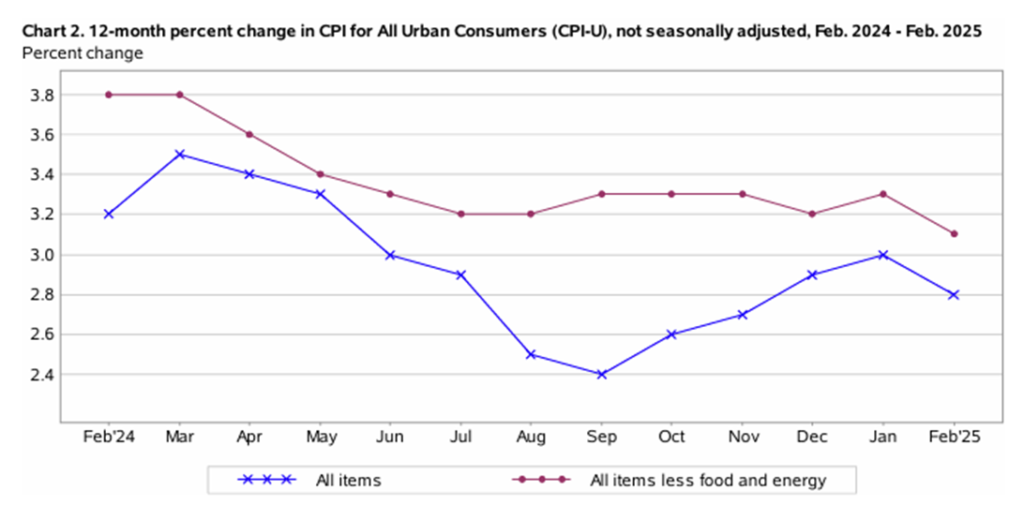
If you believe what President Trump and his people are saying about the economy, I can see why you support him. But since he entered office, the economy has begun to wobble. Consequently, his propaganda machine is now in overdrive trying to convince Americans he is doing great things.
While you may be one of those content to take Trump at his word, it doesn’t hurt to validate what he is saying. Are his actions helping or hurting the economy? Let’s take a look.
Trump is taking credit for easing inflation to the lowest level in years, creating soaring job growth, and moving the economy in the right direction after years of failure by the Biden Administration.
A White House Press Release on March 12 is titled, “WINNING: Inflation Eases as Job Creation Soars and Border Security Pays Off.”
Let me quote two portions:
“Today’s CPI report shows inflation is declining and the economy is moving in the right direction under President Trump. Core consumer prices, which is the best measure of inflation, dropped to its lowest level in FOUR years. This inflation report, much like last week’s jobs report, is far better than the media predicted and the so-called ‘experts’ expected. When will they learn to stop doubting President Trump? As he successfully did in his first term, President Trump is driving down costs through massive deregulation and energy dominance. The entire Trump Administration will continue to focus on fixing the economic and inflation nightmare created by the Biden-Harris Administration to unlock the Golden Age of America.”
— Karoline Leavitt, White House Press Secretary
“Today’s Consumer Price Index showed inflation ‘eased more than expected’ in February as Americans finally see some welcome relief following years of unending Bidenflation — with core inflation at its lowest level in nearly four years and mortgage rates dropping to their lowest levels since December.”
Reading these two statements leads one to believe that inflation dropped to its lowest level in four years. Also, both the inflation and jobs report were much better than the media and experts predicted, and they have been doubting the President all along. Finally, we are told that Americans are finally beginning to see some relief after years of unending Biden inflation (a “nightmare”).
Let’s dissect these claims, one by one.
In truth, inflation was easing for many months under the Biden Administration, and February’s inflation numbers are not at all remarkable.
Two of the ways inflation (CPI or Consumer Price Index) is measured are by an annual percentage increase reflecting the previous 12 months, or the monthly percentage increase in inflation. Thus, the February 2025 report indicated inflation was at 2.8% based on the 12-month period of March 2024 through February 2025. For February 2025, the percentage change in inflation was 0.2%.
In addition, the 12-month change in CPI is reported in two ways: the inflation rate for “all items,” and the rate for “all items less food and energy.” This latter measure is called “core inflation” because it excludes price changes in food and energy that tend to be more “volatile.”
So let me display two graphs to enable us to assess Trump’s claims. The first is the 12-month percent change going back to February 2024.

As you can see the February 2025 number was 2.8% for all items (blue), and 3.1% for all items less food and energy (red, e.g., “core inflation”). As you can clearly see, the inflation percentage for all items (blue line) was lower than 2.8% for several months during 2024 (August, September, October, and November). This means inflation was actually lower when Biden was in office. Also, core inflation (red line) at 3.1% was just slightly lower than many previous months of readings in the range of 3.2% to 3.3%. This means core inflation under Biden was only slightly higher than February’s reading under Trump.
But think about what is being said with these numbers. Trump’s “four year record” on the core inflation percentage is based on the period of March 2024 through February 2025. This is as much or Biden’s success as it is Trump’s success because it includes many months of positive readings under Biden.
To get an idea of what Trump actually achieved since entering office, we need to look at the monthly percentage changes.

Here you can see that CPI went up by 0.2% during February 2025. This is much less than January (0.5%, which Trump shared with Biden), as well as November and December of 2024. However, there were six months during 2024 when the monthly inflation rate was at or less than 0.2%. This means inflation during these months was at or lower than Trump’s February 2025 number.
Consequently, it’s erroneous to say Americans are finally getting some relief on inflation, or that Biden’s inflation was a nightmare and unending. It is also erroneous to say that Trump is driving down costs because the vast majority of goods and services haven’t come down in cost.
In truth, the February 2025 Jobs Report does not reflect “soaring” job growth; instead going back to February 2023, there were 14 months where job gains exceeded the 151,000 reported in February 2025.
Below is a chart that depicts monthly job gains going back to February 2023. I’m also adding a data box that helps you see the month to month numbers more specifically. For instance, in February of 2023, you can see that 306,000 jobs were added, and in April 2023, 216,000 were added. You can also see massive job gains in November and December of 2024. In fact, there were 14 months since February 2023 where job gains during Biden’s tenure exceeded the 151,000 reported for February 2025.


Clearly, the number reported for February 2025 is not “soaring.” In fact, it is rather average.
Trump’s claims regarding easing inflation and soaring job growth were made prior to his system of tariffs being implemented and prior to federal job losses due to massive layoffs, firings, and buyouts.
Upon taking office, Trump signed an executive order imposing tariffs on imports from Mexico, Canada and China — 10% on all imports from China and 25% on imports from Mexico and Canada starting Feb. 4. However, he subsequently agreed to a 30-day pause on his tariff threats against Mexico and Canada.
The bottom line is that most of Trump’s proposed tariffs have yet to be put into effect. Most economists conclude tariffs will have an inflationary effect. Consequently, Trump’s claim of reversing inflation could either be premature or just plain wrong.
In addition, the survey period for the Bureau of Labor Statistics (BLS) job reports is early in the month. This means that job losses occurring after the survey period aren’t included. Tens of thousands of federal employees have been fired, laid off, or given buyouts since early February. These numbers will find their way into job reports for March 2025 and beyond. Also, if the federal government adopts massive cuts to programs administered by the states (e.g., Medicaid and SNAP), this will lead to losses in government employment at the state and local levels.
Finally, tariffs could also lead to job losses in the private sector. Businesses will cope with the dilemma of passing prices onto consumers or trimming their workforces to absorb costs.
During his run for the Presidency, Trump never informed Americans that implementing a system of tariffs and downsizing the federal government could cause some short-term pain and disruption to the economy.
There are only two possibilities here. Trump either knew there would be negative consequences and chose to withhold this information from us, or he was in denial about the potential negative effects of his actions.
Let’s assume Trump knew that implementing tariffs would cause inflation, spook the stock market, and possibly lead to a recession. He knew that massive cuts to federal government would affect job numbers and the health of the economy. If he knew, why didn’t he tell us? There is only one answer. He decided not to tell us about these problems because it affected his electability. I don’t know about you, but I regard this as deception and betrayal.
The second possibility is that Trump was in denial that tariffs could be disruptive to the stock market, inflationary, or recession inducing. He didn’t accept that massive cuts to federal government, including massive workforce reductions, would affect job numbers and the health of the economy. If this is the case, his competence is called into question. When bad outcomes occurred because of these actions, he needed an excuse. Thus, we are being told that all will be great in the long run if we just soldier through some short-term disruptions to get the country back on track.
Regardless of which possibility you choose, it’s a damning indictment of President Trump. He either deceived and betryed us by withholding critical information, or he is incompetent for failing to recognize and plan for the negative conditions that are now upon us.
The bottom line is that Trump’s actions have wobbled the economy in just a few short weeks. His propaganda messaging does not hold up to scrutiny. And we cannot accept or trust his reasoning that disruptions will be short-term in nature and worth the price.
Conclusion: Americans aren’t buying Trump’s propaganda as they increasingly disapprove of his handling of the economy.
Recent polls reveal that Americans increasingly disapprove of Trump’s handling of the economy.
In a CNN/SSRS poll released on March 12, 56% of those responding said they disapproved of Trump’s handling of the economy, while 45% approved. A Reuters/Ipsos poll also released that day found that 57% believe Trump’s economic policies have been too “erratic”. And according to the Reuters/Ipsos poll conducted February 12 -18, 53% of Americans believed the economy was on the wrong track. This is up from 43% in the organizations’ poll of January 24-26.
Americans don’t want to hear excuses and spin. Their key barometer is their personal finances, and they don’t seem to be liking what they’re seeing since Trump took office.
Leave a Reply